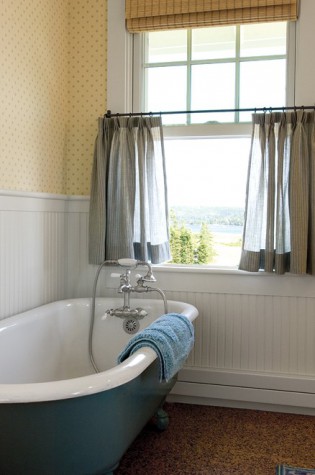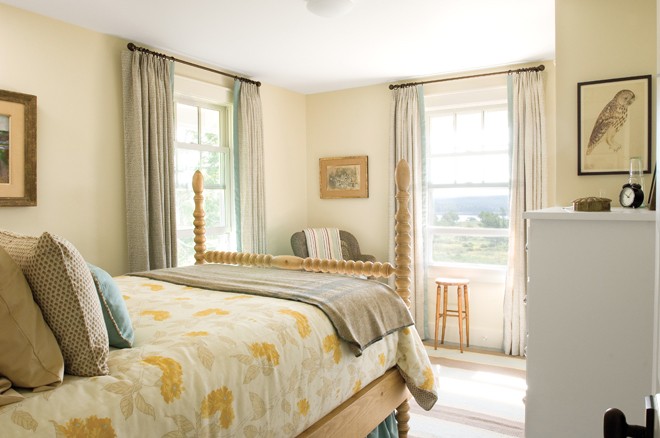Farmhouse Guesthouse
A coastal farmhouse transforms into a peaceful guesthouse
When interior designer Brett Johnson’s close friend married into a prominent American family, Johnson and his Maine Street Design Co. in Portland became that family’s new go-to designer. First assignment? Additional work on a solar-powered home on an island off the coast of Maine. Second? The new couple’s primary residence. Third? An empty farmhouse, also on the island off the coast of Maine. The new couple wasn’t going to live in the farmhouse, and neither was anyone else in the immediate family. The third assignment was geared exclusively to guests.
A few years before the farmhouse project, a finished post-and-beam barn had been built on the island for yoga practice, meditation retreats, theater groups, dances, conferences, weddings, and dinners. The space allowed gatherings to be held “in a pure, clean, beautiful place, untainted by the commercial world,” says architect Roc Caivano of Bar Harbor. But the barn activities meant more visitors. Although the island had once been farmed, it was no longer, so the family decided to renovate the vacant farmhouse for guests.
To make this work, Caivano did what he describes as “a hip replacement” on the building. He shored up the existing structure, gutted the kitchen, and fashioned the master bedroom out of what he describes as “a jumble of spaces.” Outside, he added an entry porch, a second-floor balcony, a deck, and a terrace. All the electrical, heating, and plumbing systems were updated. On approach, the home still reads as modest. One simply sees an L-shaped farmhouse with two hip roofs. If there’s an obvious update, it’s the pergola, and that’s only because it’s not yet crowded with old vines.
Johnson was charged with completely outfitting the result of Caivano’s efforts. With the exception of a few antiques and pieces of art, Johnson and his team chose or made everything for the home: furniture, linens, dishes, even custom-fused plastic tissue boxes and trash bins to match the bathroom window treatments. While everywhere evoking its farm roots, the house is now delicately colored and supremely comfortable—simple yet sumptuous. It feels like the Platonic ideal of a coastal farmhouse. “It’s like the house you always wanted to live in,” one visitor says. And yet it’s also like nothing you’ve ever seen before, in part because so much in the house is one-of-a-kind.
When Johnson first started his business 18 years ago, he wasn’t finding the material he was looking for, so he nurtured local craftspeople who could build for him (under the auspices of Maine Street Mercantile and Manufacturing) and colleagues who could produce fine bedding and draperies (like Maine Street Design Co.’s Alice Mobley). For the farmhouse, Johnson combined the products of these relationships with antiques, local Maine goods, and a handful of high-end purchases.
For example, in one guest bedroom, a white scallop-edged night table and tall dresser (made by Maine Street Mercantile and Manufacturing) accompany a bed that consists of an old iron frame (that Johnson found and had encrusted with paint), a duvet cover by Mobley, and a throw from the Maine Blanket. An antique wicker chair with a yellow cushion made by Alfred’s Upholstery and Co. in East Waterboro sits next to the bed. A Barrier Island rug is on the floor. Sconces from the designer lighting outfit Visual Comfort and Co. are on the wall. The floor is painted, as are most of the floors in the house, each a different color.
Similarly, the master bathroom, which was originally a moldy bedroom and closet, is now outfitted with a yard-sale slipper chair (reupholstered with waterproof yachting cloth), sheer curtains by Mobley, a restored and painted tub (original to the house), and a geometric rug from Company C.
The kitchen and communal spaces are, of course, at the center of the home. Caivano, Johnson, and Connie Dedam of Ellsworth’s Interiors by Details collaborated on the kitchen. Their idea was to create a space that was conducive to gathering but also to occasional use. Although many of the cupboards have beadboard trim (in keeping with the coastal farmhouse style), others have glass doors, so people who don’t really know the kitchen can see inside. Guests can gather around the island, which has a peninsula overhang to accommodate stools, or at the locally sourced walnut dining room table, which was purposely curved by builder Greg Zoulamis of Bowdoinham to make conversation easier. Although the room has all the modern conveniences, Johnson wanted it to have a “bright country flavor.” The cabinets are white, the floors a stained pine, and the accent colors include teal and a range of reds, with brown-red on the dining room chairs, an orange-red on the window treatments, and a bright red on the kitchen stools. Despite a comfortably sized budget, Johnson did not consider the project “an opportunity to spend endless sums of money.” The wine glasses are from IKEA, and some of the dishware is from Crate and Barrel.
For the most part, Johnson could do as he wished with the design, but his friend did have one specific request. She had found some wallpaper with a sweet pea pattern that seemed perfect for a summer cottage. She didn’t care where it was used; she just wanted it to appear somewhere. It ended up in a ground-floor bedroom suite. “We took pink to a whole different level in that suite,” says Johnson, referencing the lampshades, hand-tufted quilt, pillows, ceramic dresser knobs, and glass bathroom vanity knobs, all in the color. It might sound gaudy, but the suite is anything but. The pinks are complex but soft.
There is much that is grand about the extended family that Johnson’s friend married into. There’s a grand history but also grandness in personal spaces. The present generation remains influential and affluent, but its wants, when it comes to the island, are for preservation and peace. Johnson describes the land as a gift from the patriarch “to his children and grandchildren, a place where they could all feel comfortable.” The new farmhouse lets the family extend that graciousness to others.






























